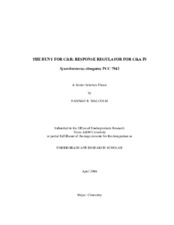| dc.description.abstract | Circadian rhythms are daily cycles of activity that have been demonstrated in many organisms including bacteria, fungi, insects, plants, and mammals. A clock system is composed of three parts: the input pathway, the central oscillator, and the output pathway. The input pathway takes temporal and environmental signals and transfers that information to the central oscillator, which contains the core components of the clock, to synchronize the endogenous clock with the environment. Temporal cues are then sent through output pathways to control certain cell processes. The CikA (circadian input kinase) protein is an integral part of the input pathway because a cikA mutant cannot reset its circadian rhythm in response to dark pulses. CikA contains a histidine protein kinase (HPK) domain, which suggests that CikA is part of a bacterial two-component signal transduction system in which CikA autophosphorylates in response to a signal and transfers that phosphate to a putative partner response regulator (RR), named CikR. The purpose of this project is to identify CikR. Bioinformatic analysis of the Synechococcus elongatus PCC 7942 genome identified nineteen potential cikR genes. Thirteen of the cikR candidates were eliminated due to their proximity to another HPK, or because their function was known and unrelated to the clock. Five of the remaining six genes were cloned and their protein products were overexpressed in Escherichia coli. Each protein was purified by affinity chromatography and used in trans--phosphorylation experiments to determine if a phosphoryl group can be transferred from radio-labeled, phosphorylated CikA to any CikR candidate. To date, no phosphoryl transfer has been detected; however, the sixth gene is currently being cloned for future tests. In vivo analysis of null alleles and overexpression constructs in the cyanobacterium has shown that at least two of the cikR candidate genes is necessary for normal circadian clock function as measured by luciferase reporters. | en |


